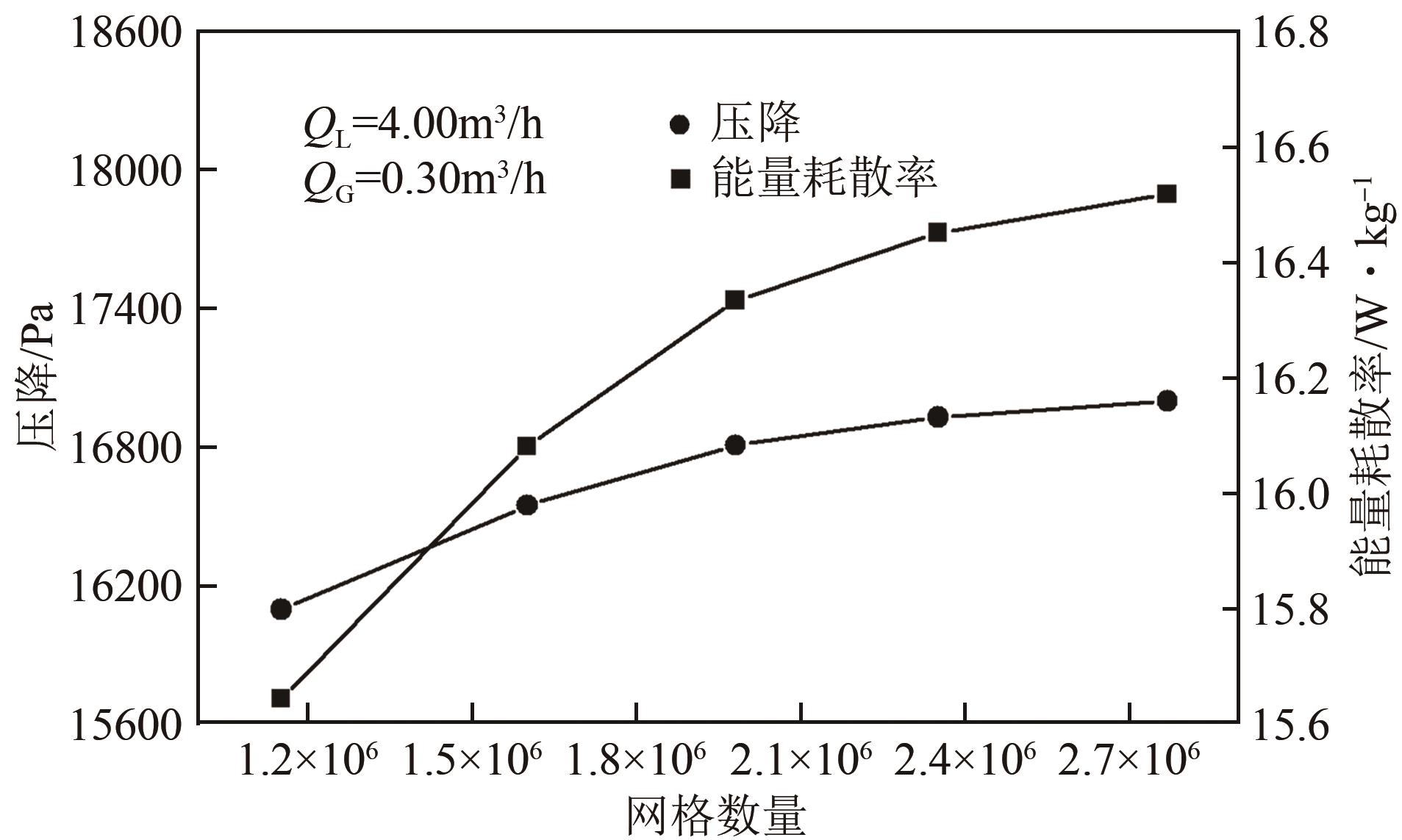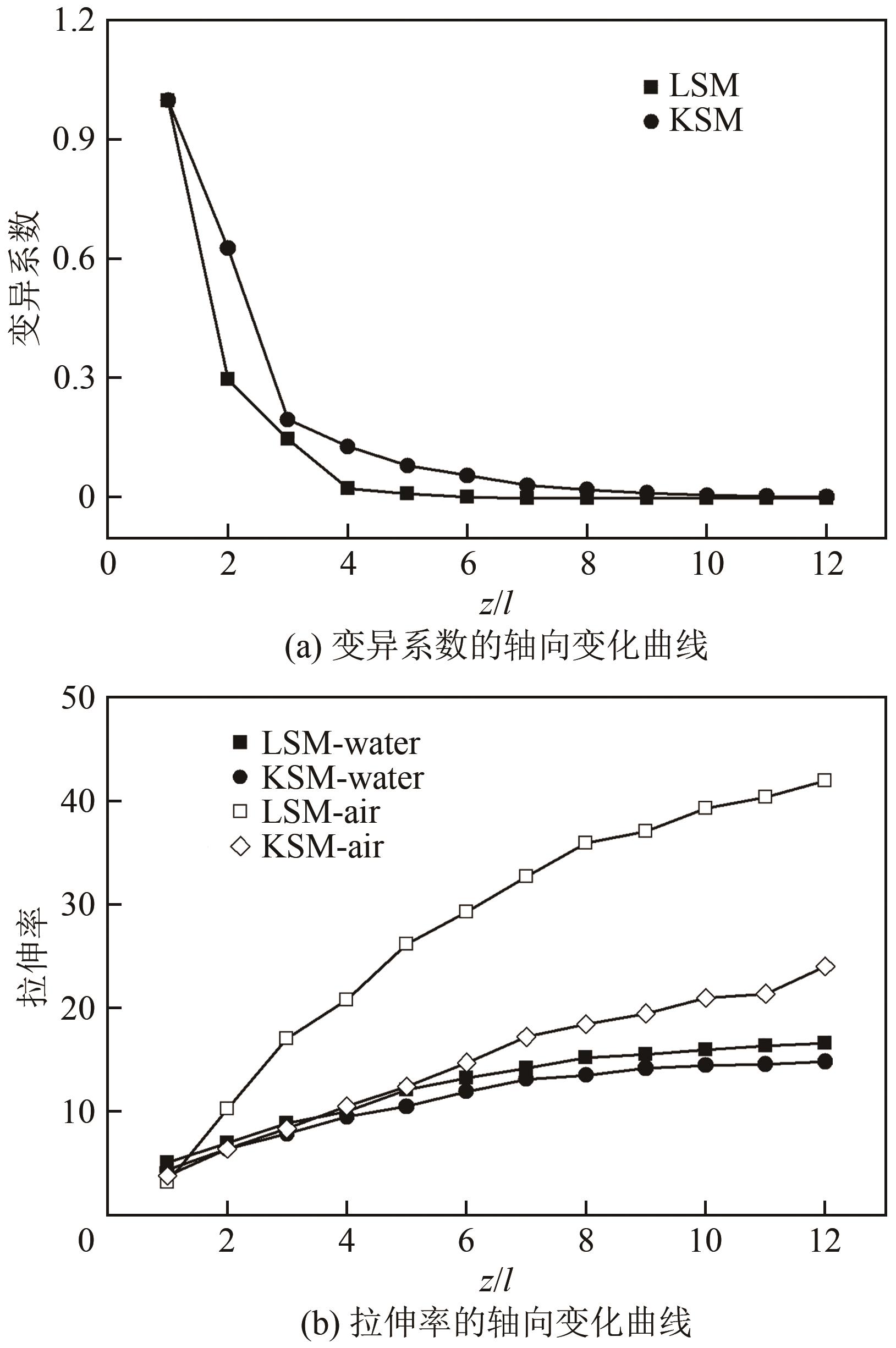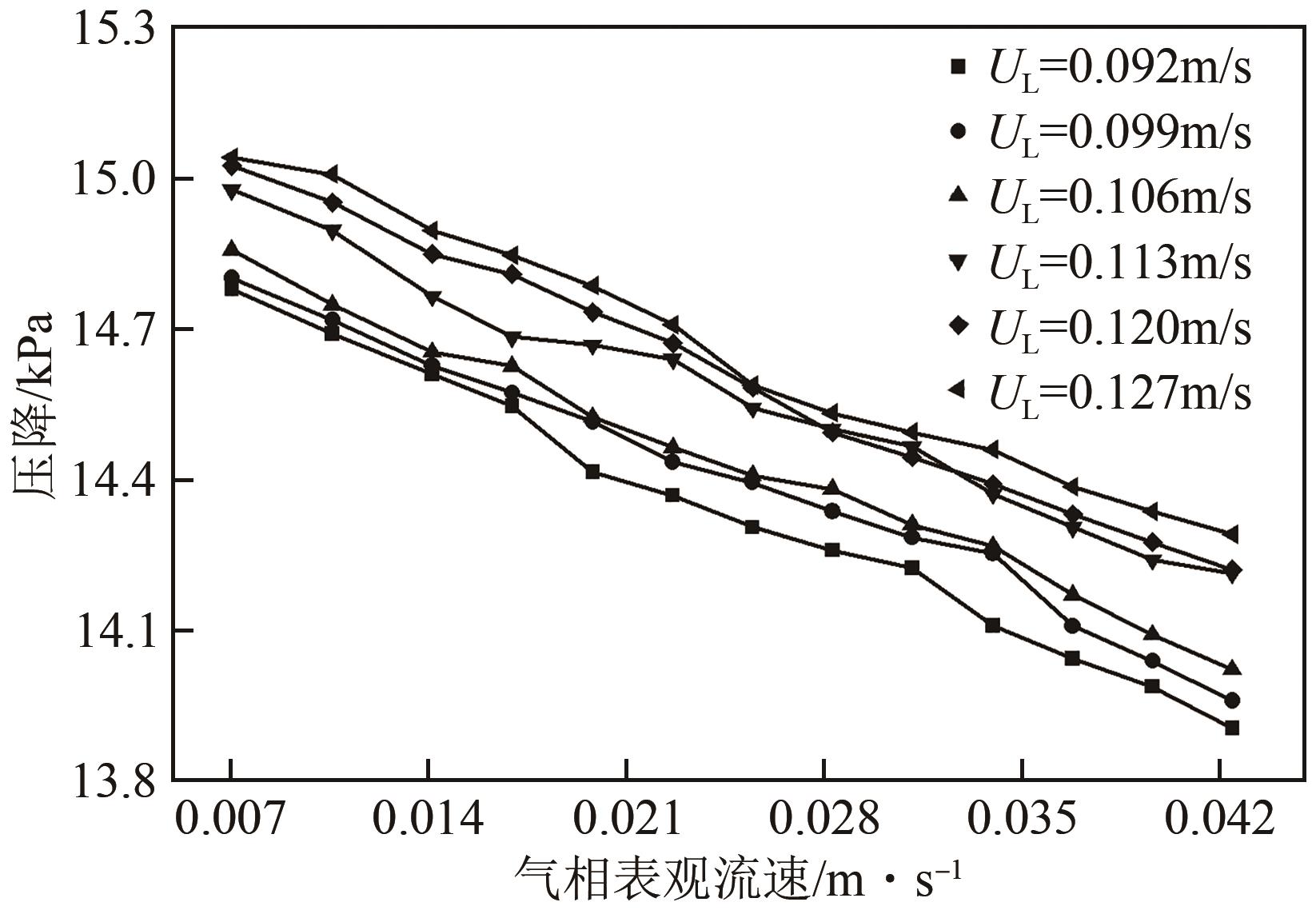化工进展 ›› 2023, Vol. 42 ›› Issue (12): 6180-6190.DOI: 10.16085/j.issn.1000-6613.2023-0183
• 化工过程与装备 • 上一篇
Lightnin静态混合器内气液两相混合与传质强化特性
- 1.沈阳化工大学机械与动力工程学院,辽宁 沈阳 110142
2.中国石油大学(华东)新能源学院,山东 青岛 266580
-
收稿日期:2023-02-13修回日期:2023-03-14出版日期:2023-12-25发布日期:2024-01-08 -
通讯作者:孟辉波 -
作者简介:禹言芳(1979—),女,博士,副教授,研究方向化工过程强化。E-mail: taroyy@163.com。 -
基金资助:辽宁特聘教授计划(辽教函〔2018〕35号);国家自然科学基金(21476142);青岛市自然科学基金(23-2-1-236-zyyd-jch);辽宁省教育厅重点项目(LJKZ0429);辽宁省自然科学基金(2022-MS-290);中国石油大学(华东)引进人才科研基金(R20220113)
Enhancement of gas-liquid flow mixing and mass transfer in Lightnin static mixer
YU Yanfang1( ), LI Yu1, MENG Huibo2(
), LI Yu1, MENG Huibo2( ), LIU Huanchen1
), LIU Huanchen1
- 1.School of Mechanical and Power Engineering, Shenyang University of Chemical Technology, Shenyang 110142, Liaoning, China
2.College of New Energy, China University of Petroleum (East China), Qingdao 266580, Shandong, China
-
Received:2023-02-13Revised:2023-03-14Online:2023-12-25Published:2024-01-08 -
Contact:MENG Huibo
摘要:
采用计算流体力学(CFD)耦合群体平衡模型(PBM)研究Lightnin静态混合器(LSM)内气泡分散特性,使用不同的破碎核和聚并核函数系统研究雷诺数(Re)、气相体积分数(αd)和元件数量对气泡分散行为以及混合效率的影响,采用气液界面积和体积传质系数(kLa)量化LSM和Kenics静态混合器(KSM)内气泡破碎性能以及传质速率,基于变异系数(CoV)和流体微元拉伸率分析LSM和KSM的分布混合性能和分散混合性能。结果表明:Luo聚并模型和Prince模型高估了LSM内气泡的聚并效率,通过Luo-Turbulent模型计算的气泡尺寸与实验数值具有很好的一致性;随着Re和αd的增大,LSM内气泡的分散行为被进一步强化,在高Re的条件下增大元件数量可以显著提高气液传质效率;CoV曲线表明,LSM具有比KSM更好的分布混合性能,3个LSM元件可以保证混合程度大于95%。LSM的分散混合效率是KSM的1.06~1.16倍;基于压力波动信号时间序列,确定了LSM中流型从过渡区向非均匀区转变的临界表观速度。
中图分类号:
引用本文
禹言芳, 李毓, 孟辉波, 刘桓辰. Lightnin静态混合器内气液两相混合与传质强化特性[J]. 化工进展, 2023, 42(12): 6180-6190.
YU Yanfang, LI Yu, MENG Huibo, LIU Huanchen. Enhancement of gas-liquid flow mixing and mass transfer in Lightnin static mixer[J]. Chemical Industry and Engineering Progress, 2023, 42(12): 6180-6190.
| 模型 | 索特平均直径/mm | 相对偏差/% |
|---|---|---|
| Luo-Turbulent | 2.808 | 4.23 |
| Luo-Liao | 2.388 | 4.91 |
| Luo-Prince | 3.552 | 21.14 |
| Luo-Luo | 7.321 | 153.89 |
| Lehr-Turbulent | 1.492 | 48.97 |
| Lehr-Liao | 1.149 | 60.65 |
| Lehr-Prince | 2.132 | 27.05 |
| Lehr-Luo | 6.161 | 110.96 |
表1 不同模型计算结果与实验值对比误差
| 模型 | 索特平均直径/mm | 相对偏差/% |
|---|---|---|
| Luo-Turbulent | 2.808 | 4.23 |
| Luo-Liao | 2.388 | 4.91 |
| Luo-Prince | 3.552 | 21.14 |
| Luo-Luo | 7.321 | 153.89 |
| Lehr-Turbulent | 1.492 | 48.97 |
| Lehr-Liao | 1.149 | 60.65 |
| Lehr-Prince | 2.132 | 27.05 |
| Lehr-Luo | 6.161 | 110.96 |
| 1 | 初广文, 廖洪钢, 王丹, 等. 微纳介尺度气液反应过程强化[J]. 化工学报, 2021, 72(7): 3435-3444. |
| CHU Guangwen, LIAO Honggang, WANG Dan, et al. Gas-liquid reaction process intensification at micro-/nano-mesoscale[J]. CIESC Journal, 2021, 72(7): 3435-3444. | |
| 2 | 刘有智. 谈过程强化技术促进化学工业转型升级和可持续发展[J]. 化工进展, 2018, 37(4): 1203-1211. |
| LIU Youzhi. Discussion on process intensification technology to promote the transformation, upgrading and sustainable development of chemical industry[J]. Chemical Industry and Engineering Progress, 2018, 37(4): 1203-1211. | |
| 3 | CHABANON E, SHEIBAT-OTHMAN N, MDERE O, et al. Drop size distribution monitoring of oil-in-water emulsions in SMX+ static mixers: Effect of operating and geometrical conditions[J]. International Journal of Multiphase Flow, 2017, 92: 61-69. |
| 4 | THAKUR R K, VIAL C, NIGAM K D P, et al. Static mixers in the process industries — A review[J]. Chemical Engineering Research and Design, 2003, 81(7): 787-826. |
| 5 | GHANEM A, LEMENAND T, DELLA VALLE D, et al. Static mixers: Mechanisms, applications, and characterization methods—A review[J]. Chemical Engineering Research and Design, 2014, 92(2): 205-228. |
| 6 | HEYOUNI A, ROUSTAN M, DO-QUANG Z. Hydrodynamics and mass transfer in gas-liquid flow through static mixers[J]. Chemical Engineering Science, 2002, 57(16): 3325-3333. |
| 7 | AZIZI F, TAWEEL A M AL. Mass transfer in an energy-efficient high-intensity gas-liquid contactor[J]. Industrial & Engineering Chemistry Research, 2015, 54(46): 11635-11652. |
| 8 | ALTABASH G, AL-HINDI M, AZIZI F. Intensifying the absorption of CO2 in water using a static mixer. part I: Effect of measurement technique[J]. Industrial & Engineering Chemistry Research, 2020, 59(25): 11691-11704. |
| 9 | RABHA S, SCHUBERT M, GRUGEL F, et al. Visualization and quantitative analysis of dispersive mixing by a helical static mixer in upward co-current gas-liquid flow[J]. Chemical Engineering Journal, 2015, 262(15): 527-540. |
| 10 | MEINECKE M, KILZER A, WEIDNER E. Imaging method for mass transport measurements in a two-phase bubbly flow of supercritical CO2 and viscous liquids in a static mixer[J]. The Journal of Supercritical Fluids, 2020, 159(1): 104757. |
| 11 | SCALA M, GAMET L, L-M MALBEC, et al. Hydrodynamics of gas-liquid dispersion in transparent Sulzer static mixers SMXTM [J]. Chemical Engineering Science, 2020, 213(23): 115398. |
| 12 | MENG Huibo, HAO Yuning, YU Yanfang, et al. Experimental study of gas-liquid two-phase bubbly flow characteristics in a static mixer with three twisted leaves[J]. Korean Journal of Chemical Engineering, 2020, 37(11): 1859-1866. |
| 13 | XU Yanxia, WANG Lüliang, WANG Yongjie, et al. Gas-liquid flow pattern identification and bubble characteristics analysis in a static mixer based HiPOxTM reactor[J]. Chemical Engineering Science, 2023, 267(5): 118269. |
| 14 | ZIDOUNI F, KREPPER E, RZEHAK R, et al. Simulation of gas-liquid flow in a helical static mixer[J]. Chemical Engineering Science, 2015, 137(1): 476-486. |
| 15 | LUO He’an, SVENDSEN H F. Theoretical model for drop and bubble breakup in turbulent dispersions[J]. AIChE Journal, 1996, 42(5): 1225-1233. |
| 16 | HADDADI M M, HOSSEINI S H, RASHTCHIAN D, et al. CFD modeling of immiscible liquids turbulent dispersion in Kenics static mixers: Focusing on droplet behavior[J]. Chinese Journal of Chemical Engineering, 2020, 28(2): 348-361. |
| 17 | MENG Huibo, WANG Jianbao, YU Yanfang, et al. CFD-PBM numerical study on liquid-liquid dispersion in the Q-type static mixer[J]. Industrial & Engineering Chemistry Research, 2021, 60(49): 18121-18135. |
| 18 | LEHR F, MILLIES M, MEWES D. Bubble-size distributions and flow fields in bubble columns[J]. AIChE Journal, 2002, 48(11): 2426-2443. |
| 19 | WANG Tiefeng, WANG Jinfu, JIN Yong. A novel theoretical breakup kernel function for bubbles/droplets in a turbulent flow[J]. Chemical Engineering Science, 2003, 58(20): 4629-4637. |
| 20 | WU Yuxue, CHEN Hang, SONG Xingfu. Experimental and numerical study on the bubble dynamics and flow field of a swirl flow microbubble generator with baffle internals[J]. Chemical Engineering Science, 2022, 263(14): 118066. |
| 21 | HAN Luchang, LUO He’an, LIU Yuejin. A theoretical model for droplet breakup in turbulent dispersions[J]. Chemical Engineering Science, 2011, 66(4): 766-776. |
| 22 | HAN Luchang, GONG Shenggao, LI Yongqiang, et al. A novel theoretical model of breakage rate and daughter size distribution for droplet in turbulent flows[J]. Chemical Engineering Science, 2013, 102(11): 186-199. |
| 23 | HAN Luchang, GONG Shenggao, LI Yongqiang, et al. Influence of energy spectrum distribution on drop breakage in turbulent flows[J]. Chemical Engineering Science, 2014, 117(27): 55-70. |
| 24 | ZHANG Xibao, LUO Zhenghong. Effects of bubble coalescence and breakup models on the simulation of bubble columns[J]. Chemical Engineering Science, 2020, 226(23): 115850. |
| 25 | XING Chutian, WANG Tiefeng, GUO Kunyu, et al. A unified theoretical model for breakup of bubbles and droplets in turbulent flows[J]. AIChE Journal, 2015, 61(4): 1391-1403. |
| 26 | LIAO Yixiang, RZEHAK R, LUCAS D, et al. Baseline closure model for dispersed bubbly flow: Bubble coalescence and breakup[J]. Chemical Engineering Science, 2015, 122(27): 336-349. |
| 27 | HUANG Guangyuan, CAI Kangbei, CHEN Wuguang, et al. Numerical simulation of two-phase hydrodynamics and mass transfer inside a serpentine tubular gas-liquid reactor[J]. Chemical Engineering Science, 2021, 245(14): 116960. |
| 28 | GUO Xiaofeng, ZHOU Qiang, LI Jun, et al. Implementation of an improved bubble breakup model for TFM-PBM simulations of gas-liquid flows in bubble columns[J]. Chemical Engineering Science, 2016, 152(2): 255-266. |
| 29 | SHI Weibin, YANG Jie, LI Guang, et al. Modelling of breakage rate and bubble size distribution in bubble columns accounting for bubble shape variations[J]. Chemical Engineering Science, 2018, 187(21): 391-405. |
| 30 | TSOURIS C, TAVLARIDES L L. Breakage and coalescence models for drops in turbulent dispersions[J]. AIChE Journal, 1994, 40(3): 395-406. |
| 31 | AZIZI F, TAWEEL A M AL. Algorithm for the accurate numerical solution of PBE for drop breakup and coalescence under high shear rates[J]. Chemical Engineering Science, 2010, 65(23): 6112-6127. |
| 32 | AZIZI F, TAWEEL A M AL. Turbulently flowing liquid-liquid dispersions. Part I: Drop breakage and coalescence[J]. Chemical Engineering Journal, 2011, 166(2): 715-725. |
| 33 | LEBAZ N, AZIZI F, SHEIBAT-OTHMAN N. Modeling droplet breakage in continuous emulsification using static mixers in the framework of the entire spectrum of turbulent energy[J]. Industrial & Engineering Chemistry Research, 2022, 61(1): 541-553. |
| 34 | VALDÉS J P, KAHOUADJI L, MATAR O K. Current advances in liquid-liquid mixing in static mixers: A review[J]. Chemical Engineering Research and Design, 2022, 177: 694-731. |
| 35 | 禹言芳, 刘桓辰, 孟辉波, 等. Lightnin静态混合器内气泡分散流体动力学特性实验研究[J]. 化工学报, 2022, 73(8): 3565-3575. |
| YU Yanfang, LIU Huanchen, MENG Huibo, et al. Experimental investigation of turbulent dispersion and hydrodynamic behavior of bubble in Lightnin static mixer[J]. CIESC Journal, 2022, 73(8): 3565-3575. | |
| 36 | GUAN Xiaoping, YANG Ning. Bubble properties measurement in bubble columns: From homogeneous to heterogeneous regime[J]. Chemical Engineering Research and Design, 2017, 127: 103-112. |
| 37 | YU Yanfang, YANG Peng, MENG Huibo, et al. Bubble morphology analysis and pressure drop of gas-liquid two-phase flow inside a quarto static mixer[J]. Industrial & Engineering Chemistry Research, 2022, 61(50): 18574-18587. |
| 38 | TOMIYAMA A, KATAOKA I, ZUN I, et al. Drag coefficients of single bubbles under normal and micro gravity conditions[J]. JSME International Journal Series B: Fluids and Thermal Engineering, 1998, 41(2): 472-479. |
| 39 | MENG Huibo, HAN Mengqi, YU Yanfang, et al. Numerical evaluations on the characteristics of turbulent flow and heat transfer in the Lightnin static mixer[J]. International Journal of Heat and Mass Transfer, 2020, 156: 119788. |
| 40 | CHEN Siyuan, OUYANG Yi, VANDEWALLE L A, et al. CFD analysis on hydrodynamics and residence time distribution in a gas-liquid vortex unit[J]. Chemical Engineering Journal, 2022, 446: 136812. |
| 41 | MENTER F R. Two-equation eddy-viscosity turbulence models for engineering applications[J]. AIAA Journal, 1994, 32(8): 1598-1605. |
| 42 | PRINCE M J, BLANCH H W. Bubble coalescence and break-up in air-sparged bubble columns[J]. AIChE Journal, 1990, 36(10): 1485-1499. |
| 43 | LUO He’an. Breakup and liquid circulation in bubble column reactors[D]. Trondheim: Norwegian Institute of Technology, 1993. |
| 44 | SAFFMAN P G, TURNER J S. On the collision of drops in turbulent clouds[J]. Journal of Fluid Mechanics, 1956, 1(1): 16-30. |
| 45 | ABRAHAMSON J. Collision rates of small particles in a vigorously turbulent fluid[J]. Chemical Engineering Science, 1975, 30(11): 1371-1379. |
| 46 | LIAO Yixiang, LUCAS D. A literature review on mechanisms and models for the coalescence process of fluid particles[J]. Chemical Engineering Science, 2010, 65(10): 2851-2864. |
| 47 | ANSYS Fluent 16. 0 Theory Guide[EB/OL]. . |
| 48 | MENG Huibo, MENG Tong, YU Yanfang, et al. Experimental and numerical investigation of turbulent flow and heat transfer characteristics in the Komax static mixer[J]. International Journal of Heat and Mass Transfer, 2022, 194(15): 123006. |
| 49 | MENG Huibo, WANG Feng, YU Yanfang, et al. A numerical study of mixing performance of high-viscosity fluid in novel static mixers with multitwisted leaves[J]. Industrial & Engineering Chemistry Research, 2014, 53(10): 4084-4095. |
| 50 | GOLDSHMID J, SAMET M, WAGNER M. Turbulent mixing at high dilution ratio in a Sulzer-Koch static mixer[J]. Industrial & Engineering Chemistry Process Design and Development, 1986, 25(1): 108-116. |
| [1] | 谢璐垚, 陈崧哲, 王来军, 张平. 用于SO2去极化电解制氢的铂基催化剂[J]. 化工进展, 2023, 42(S1): 299-309. |
| [2] | 王云飞, 秦蕊, 郑利军, 李焱, 李清平. 旋转填充床CFD模拟研究进展[J]. 化工进展, 2023, 42(S1): 1-9. |
| [3] | 赵晨, 苗天泽, 张朝阳, 洪芳军, 汪大海. 负压状态窄缝通道乙二醇水溶液传热特性[J]. 化工进展, 2023, 42(S1): 148-157. |
| [4] | 孙继鹏, 韩靖, 唐杨超, 闫汉博, 张杰瑶, 肖苹, 吴峰. 硫黄湿法成型过程数值模拟与操作参数优化[J]. 化工进展, 2023, 42(S1): 189-196. |
| [5] | 杨寒月, 孔令真, 陈家庆, 孙欢, 宋家恺, 王思诚, 孔标. 微气泡型下向流管式气液接触器脱碳性能[J]. 化工进展, 2023, 42(S1): 197-204. |
| [6] | 陈匡胤, 李蕊兰, 童杨, 沈建华. 质子交换膜燃料电池气体扩散层结构与设计研究进展[J]. 化工进展, 2023, 42(S1): 246-259. |
| [7] | 罗成, 范晓勇, 朱永红, 田丰, 崔楼伟, 杜崇鹏, 王飞利, 李冬, 郑化安. 中低温煤焦油加氢反应器不同分配器中液体分布的CFD模拟[J]. 化工进展, 2023, 42(9): 4538-4549. |
| [8] | 赵曦, 马浩然, 李平, 黄爱玲. 错位碰撞型微混合器混合性能的模拟分析与优化设计[J]. 化工进展, 2023, 42(9): 4559-4572. |
| [9] | 卜治丞, 焦波, 林海花, 孙洪源. 脉动热管计算流体力学模型与研究进展[J]. 化工进展, 2023, 42(8): 4167-4181. |
| [10] | 王保文, 刘同庆, 张港, 李炜光, 林德顺, 王梦家, 马晶晶. CuFe2O4改性脱硫渣氧载体与褐煤的反应特性[J]. 化工进展, 2023, 42(6): 2884-2894. |
| [11] | 修浩然, 王云刚, 白彦渊, 邹立, 刘阳. 准东煤/市政污泥混燃燃烧特性及灰熔融行为分析[J]. 化工进展, 2023, 42(6): 3242-3252. |
| [12] | 郭文杰, 翟玉玲, 陈文哲, 申鑫, 邢明. Al2O3-CuO/水混合纳米流体对流传热性能及热经济性分析[J]. 化工进展, 2023, 42(5): 2315-2324. |
| [13] | 卢兴福, 戴波, 杨世亮. 转鼓内圆柱形颗粒混合的超二次曲面离散单元法模拟[J]. 化工进展, 2023, 42(5): 2252-2261. |
| [14] | 刘厚励, 顾中浩, 阳康, 张莉. 3D打印槽道结构槽宽对池沸腾传热特性的影响[J]. 化工进展, 2023, 42(5): 2282-2288. |
| [15] | 常晓青, 彭东来, 李东洋, 张延武, 王景, 张亚涛. MOFs基丙烯/丙烷高效分离混合基质膜研究进展[J]. 化工进展, 2023, 42(4): 1961-1973. |
| 阅读次数 | ||||||
|
全文 |
|
|||||
|
摘要 |
|
|||||










